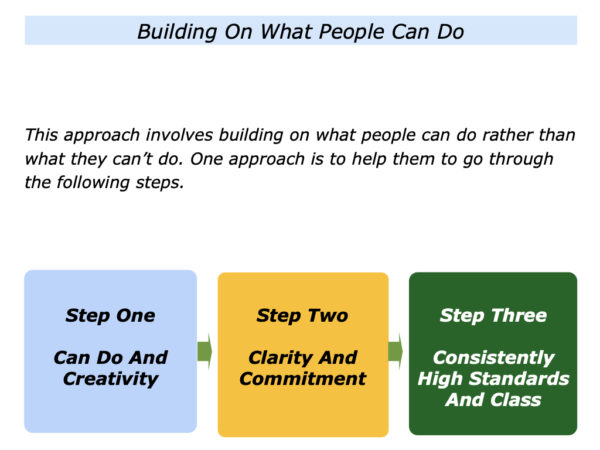
This is an approach that can be helpful when encouraging a person who may have strengths in specific activities but not be an all-rounder. It focuses on what a person can do rather than what they can’t do.
The approach can do is particularly useful when working with certain kinds of people. These include individuals who may be considered to have some of the following qualities.
To be different … To be a specialist … To be introverted … To be dyslexic … To be autistic … To be highly sensitive in some areas … To have synaesthesia … To have physical or mental abilities in some activities but not in others … To be late developers.
To be adrenaline driven … To be potentially brilliant in some areas but bored in others … To have been given a psychological label … To be somebody with a different neurological make up … To be somebody who processes information differently … To be a positive deviant.
To be intelligent in ways not normally recognised … To have extreme attention to detail in some areas … To be a pragmatist who won’t learn something unless they can see the point of it … To be somebody who sees things differently.
This is an approach that I have seen used successfully in families, education, the arts, sports, work places, business and many walks of life. It can help a person to develop by taking the following steps.
Step One: Can Do
And Creativity
This involves focusing on what a person can do rather than what they can’t do. It means building on their strengths and, at a later point, helping them manage the consequences of any weaknesses. It often calls for being creative in finding ways they can make their best contribution.
Step Two: Clarity
And Commitment
This involves clarifying how the person wants to develop their abilities and what they want to achieve. It also calls for clarifying their inner commitment. It is up to the individual, however, to decide whether they want to do what is required to achieve certain aims.
Step Three: Consistently
High Standards And Class
This involves helping the person to pursue the strategies and skills required to consistently deliver high standards. It sometimes calls for encouraging them to go a step further and use their strengths to add that touch of class.
Looking back on your life, can you think of a situation when you helped a person or a group of people to take some of these steps? You may have done this in some of the following scenarios.
When helping a young person to develop their confidence;
When helping somebody to build on their strengths and do satisfying work;
When helping a team to focus on the specific activities where they could do brilliant work.
Looking back, how did you help the person or group of people to build on what they could do? How did you help them to identify their possibilities? How did you find creative ways they could channel their strengths?
How did you help them to clarify their goals and decide if they wanted to commit to doing the work? How did you help them to deliver consistently high standards and, if appropriate, add that touch of class?
If you wish, try tackling the exercise on this theme. This invites you to describe what you did, what they did and the things that happened as a result.
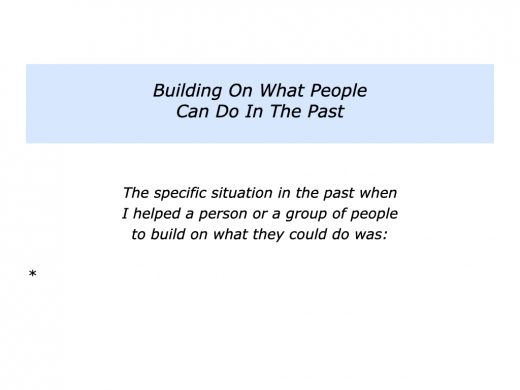
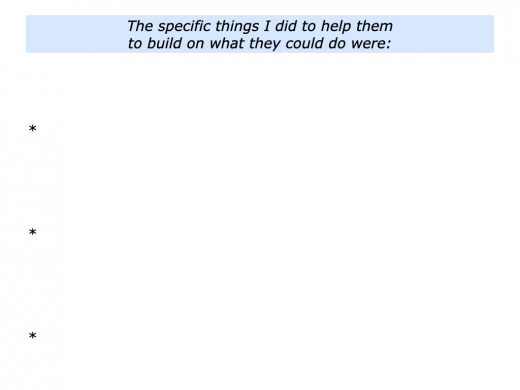
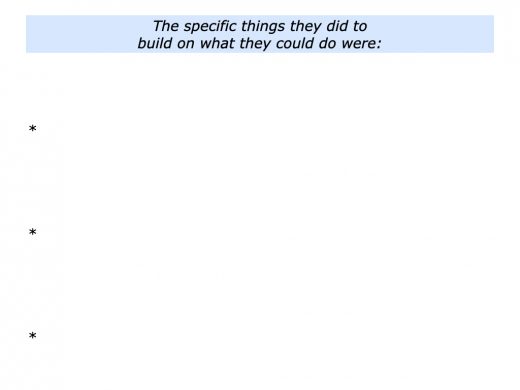
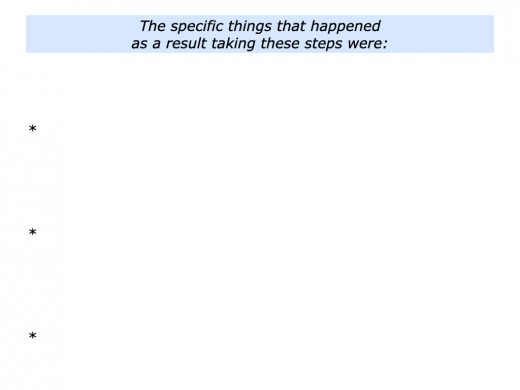
As mentioned earlier, this is an approach I have seen work in many situations. Let’s explore each of these steps.
Step One: Can
Do And Creativity
The first step is to focus on what a person can do. Alex Dickson, the founder of Voluntary Service Overseas and Community Service Volunteers, took this approach. He encouraged people to use their strengths to help others.
Below is a summary of what he said during one of our conversations. On that occasion he had just returned from Northern Ireland after talking with people who had lost limbs in bombings.
Alec encouraged them to use their experiences to help other people. They had responded enthusiastically and offered their help. Alec told me about his approach to people.
“When I look at a person in a wheelchair or a person in any situation, I look at their abilities.
“They may be able to teach young people to read, to counsel people who have had a life-changing accident, to listen to older people in a hospice, to make films that share their own experiences of being resilient.
“Whatever their situation, everybody has something to give. It is in the act of giving that people both forget themselves and find themselves.
“We can give people the chance to use their gifts to help to meet some of the unmet needs in society.”
During my work in sports I interviewed coaches in football. One coach expressed their philosophy in the following way.
“Many coaches talk about what a player can’t do, but I have a different approach. When scouting players I watch them in action – especially when things get tough – and ask the following questions.
“What is the player’s character? What are their strengths and skills? What is it they can do? How could they contribute to the team? How could we build on their strengths and compensate for any weaknesses?”
Different people focus on different things when exploring what a person can do. One approach is to focus on the person’s attitude, ability and what they may be able to achieve.
Imagine you are watching a person in action or seeing an example of their work. It can be useful to explore the following themes.
Attitude
What is the person’s attitude? Are they positive or negative? Do they take responsibility or avoid responsibility? How do they apply themselves when they are doing what they do best? How do they react to setbacks?
What is their attitude towards other people? What is their style of behaving, interacting and communicating with other people? What is their effect on other people? What are the three words you would use to describe their attitude?
Ability
What are the person’s abilities? What are their strengths? What are the specific activities in which they can do superb work? What is the evidence that they can do these things?
What is their successful style of working? When have they done superb work in the past? What did they do right then? What were the principles they followed? How did they translate these into action?
Achievement
What are the specific things the person can achieve in the future? How could they do superb work and make their best contribution? What is the application they would need to demonstrate to achieve these aims?
What will be their best way of doing superb work? Will they work best by themselves, with other people or by leading projects? How can they use their strengths to help other people to achieve their goals?
Imagine that you have taken this approach to clarifying what a person can do. The next stage is to explore creative ways they may be able:
To build on their abilities and apply these to learn, develop, do superb work or help other people to succeed;
To, if appropriate, channel these abilities towards making their best contribution to a customer, team, organisation or society.
This sometimes calls for doing creative thinking. Several years ago I worked with a team that took this approach.
The team had 8 specialists who were tech evangelists for the larger business. They also sometimes acted as trusted advisors with customers and helped them to solve problems.
A new COO was appointed at head office. Coming from a retail background, one of his first acts was to tell people they must be more sales-driven.
Speaking at the annual company gathering, he told people that he saw little difference between running a retail company and a software business.
The company needed to improve its sales performance, he said, so everybody must see themselves as a sales person. Teams would therefore be given a financial target they must deliver.
This went down like a lead balloon. But, sure enough, every team was given a sales target and sent on a sales course. This had a mixed reception.
The specialist team I worked with wanted to play to their strengths but also keep their jobs. Bearing this in mind, we explored the following options. They could aim either:
a) To try to convince the bosses that their specialist function was different and they contributed to the company in other ways;
b) To follow the instructions and ensure that each of the 8 specialists hit a specific sales target;
c) To develop their roles as trusted advisors to customers and find ways to sell when doing this role;
d) To hire a sales person and business co-ordinator for the team – which would mean two specialist moving on in order to stay within the budget;
e) To hire a sales person and a business co-ordinator, retain all the specialists and increase the team’s sales target in order to pay for these people.
Looking at this final option, the company had a background of ratifying an increase in headcount providing a team increased its financial target.
The team considered all these options – plus other routes – together with the pluses and minuses of each option. After some discussion they chose to pursue option (e).
There were many twists and turns along the way, but eventually the leader got this approach signed off by their bosses. They recruited a sales person and business co-ordinator. Cutting a long story short, the team hit its financial targets by playing to people’s strengths.
Many of the team also outlasted the COO and there were some beneficial side-effects. The specialists developed their skills as trusted advisors and ability to get extra funding. This helped them to shape successful careers in the future.
Let’s return to the person you may want to help. How can you encourage them to build on and channel their strengths?
If you wish, try tackling the exercise on this theme. Bearing in mind the person’s abilities – based on the evidence you have seen – it invites you to complete the following sentences.
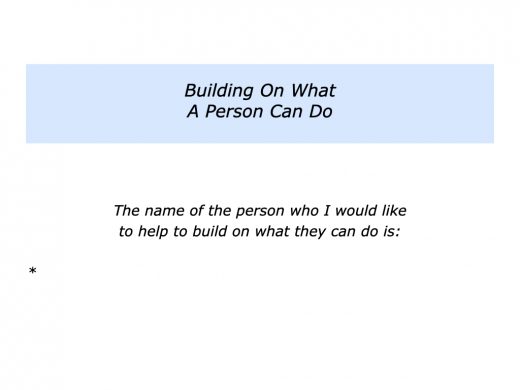
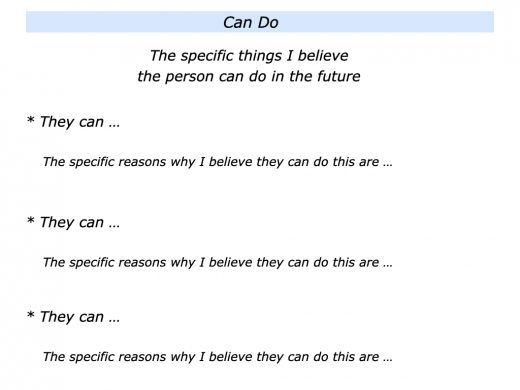
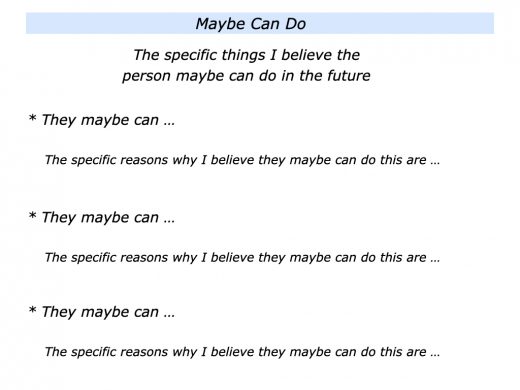
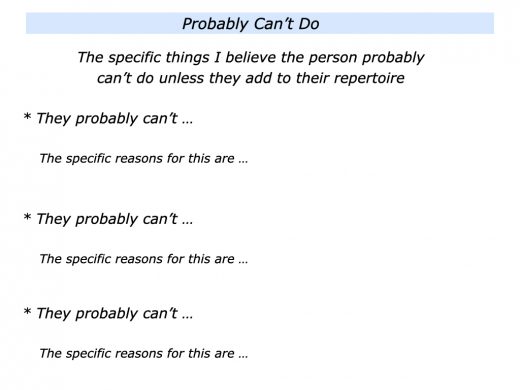
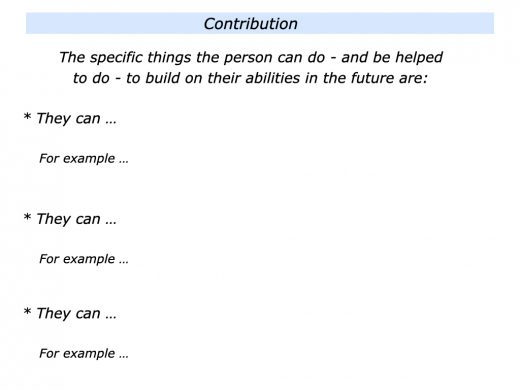
Step Two: Clarity
And Commitment
Imagine that you are encouraging a person who wants to build on their strengths. The next stage will be to explore the possible routes they can take in the future. This involves you working with the person:
To clarify what they want to do to build on their abilities and the specific results they want to achieve;
To clarify whether they want to commit themselves to doing the work involved in achieving their aims.
Different people choose to different ways to clarify what they want to achieve. The following section is based on a piece written by Bengt Elmén
Many years ago he attended a course I ran in Sweden. Here is his remarkable story, together with his views on how people can commit to achieving certain goals.
Decide Your Destiny
My own experiences with difficulty began early on – as early as birth, in fact. I had a rough delivery, during which I suffered lack of oxygen that resulted in a type of brain damage known as CP, or Cerebral Palsy.
As far as I’m concerned, though, CP actually stands for:
“Cool and Powerful”.
The brain damage diminished my ability to walk, talk and use my hands. Early on I had to learn to think of creative solutions to daily situations.
I could sit for days, for example, using my mouth and nose to piece together a 500-piece jigsaw puzzle. This taught me that it’s always worth the effort to face your difficulties rather than trying to run away from them. Such lessons have been invaluable to me as an adult.
I also learned early on how to be intimate with people. However good I was at putting together puzzles, there were many other things I couldn’t do without help.
This means that over the years, I have employed several hundred people, and from this I have gained a precious understanding of people from all walks of life.
After I earned a B.S. degree in Public Law at Stockholm’s University, I worked five years as director of the Stockholm Cooperative for Independent Living (STIL).
I wrote a book called Your Responsibility and Mine which, unfortunately, is available only in Swedish. Despite my physical disability and speech impediment, I began to travel around giving seminars and workshops.
Taking Responsibility
‘Survivor’ speeches have become very popular at conferences over the last few years.
People who invite me to speak have often heard how previous audiences began to see things in perspective. I use humour to show how I coped with my ‘tragic fate’, explaining that it is possible to see hardships from two perspectives: positive or negative.
People often leave the session finding it harder to complain about trivialities, such as the food being too cold when they go home at night. The sessions show it is possible to overcome great difficulties, rather than drown in depression.
This is a message of hope and joy – and people are forced to re-examine challenging situations in their own lives. But I have a confession to make. I am not interested in giving ‘Survivor’ speeches anymore.
Why? I am more interested in giving ‘Achiever’ speeches. I love working with Achievers.
Such people are prepared to take responsibility and build on what they have got. Deciding what they want to do, they then work hard to achieve their dreams.
People do not define the hand of cards they are given at birth, but they do decide how to use the cards. That is what I mean by Decide Your Destiny.
Whether giving keynotes or facilitating mentoring sessions, I focus on giving certain messages with people.
Take Responsibility
Achievers are prepared to take responsibility for their lives. Perhaps that is why I like working with them.
As far as I know, this is the only life I have got. I met death already at birth due to lack of oxygen, but I disregarded him. I chose life.
Since then death has been a reality to me. Life is short and it’s no use hiding from the fact that we all are going to die someday.
Therefore I want to be in charge of my own life. I want to decide how I spend the time that has been given to me. I don’t want to leave that to anyone else. It is my responsibility and I am not ready to spoil a second.
My first book in Swedish Your Responsibility And Mine provoked quite a response. Why?
Because I was urging people to do what they could do, rather than complain about what they couldn’t do. This links to my second message.
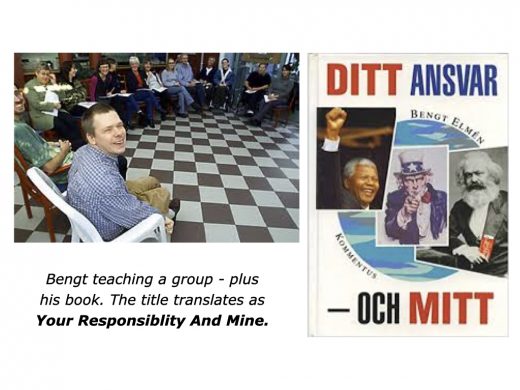
Build On What You Have Got
Did Stevie Wonder stop singing because of his lack of sight? What about José Feliciano, Ray Charles and Andrea Bocelli?
Did Stephen Hawking shape his life based on his doctors’ early death sentences? Did Helen Keller’s difficulties stop her helping other people? Did Franklin D Roosevelt refuse to carry-out the Presidency because he suffered from Polio?
If Ludwig van Beethoven had focused on what he lacked-rather than what he had – we would not have heard his Ninth Symphony and its tribute to the joy of life.
Life has taught me to build on what I have got. My physical abilities do not always reach 10/10! My walking ability is probably 3/10.
But I decided to transport myself from the physical world to the mental world – so I became fascinated by people’s hopes, ideas, plans and ambitions.
I manage the physical world with the help of technical aids and my personal assistants. For example, let me explain how I write.
Right now that I am hitting each key on my Mac with a stick that is fastened to a band around my head. It is not the fastest way in the world, but it gives me time to think about what I want to write. (Think different!)
While other authors use their hands at work, I use my head. (And heart.) So that is how you turn a limitation into a strength. That is how you build on what you have got.
And when you have chosen to concentrate on what you have got, then you also have to pick the direction of your life. This brings us to my third message.
Dare To Be An Achiever
– But Do It In Your Way
Achievers have a special quality. They decide what they want to do and then they do it.
Perhaps all of us have listened to inspiring keynote speakers who urged us to follow our dreams. But then what happens? The instant motivation begins to fade away and we return to our daily lives.
If you look back at the times you have achieved, however, it is because: a) You made an inner decision to do something; b) You were prepared to work hard; c) You did it in your own way.
Pursuing your route can be affirming yet also lonely. In order to achieve greatness, you have to discover your own path.
Unfortunately, greatness never can be accomplished by copying someone else-and sometimes it means paying less attention to what others think.
You will find it more beneficial to listen to your own inner voice when making the most important decisions in your life. Ask yourself:
“What are my innermost aspirations? What do I really want? What do I lack in my life right now? What do I want to accomplish within this lifetime?”
Creating new rules in the world can be difficult – but fun. I like to challenge people’s traditional views of how life should be. Can the future be rainbow coloured-rather than grey?
Speaking to people in the business world, the best response has always been from ‘new’ business people. They are unconventional, enjoy being challenged and want to discover new ways of looking at the world.
The new business achievers are going beyond old preconceptions. Just like the blind, deaf or disabled people I mentioned, some are prepared to follow their hearts and do what they are here to do.
My passion is to help achievers to find their purpose, possibilities and peace in life. Why?
They love freedom – the freedom to be, the freedom to create-and so do I. Sometimes we all need somebody to say: “You can do it – let’s explore how.”
My work is about helping people to make that decision – then putting it into practice. Inspirational speeches can be a start, but then comes the sweat.
People are more willing to do the hard work, however, if they have taken the responsibility to decide their destiny.
Let’s return to the situation where you may be encouraging a person. If appropriate, you can clarify the specific route they want to follow to build on their abilities. You can then encourage them:
To clarify the specific things they want to achieve and set clear goals;
To clarify the pluses and minuses involved in working towards achieving the goals;
To clarify their motivation – on a scale 0-10 – to do the work involved in achieving the goals. Make sure it is at least 8/10.
If you wish, try tackling the exercise on this theme. This invites you to complete the following sentences.
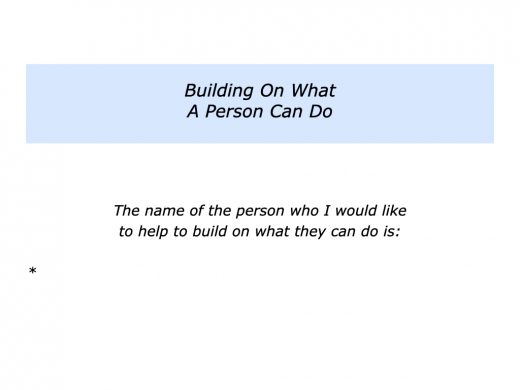
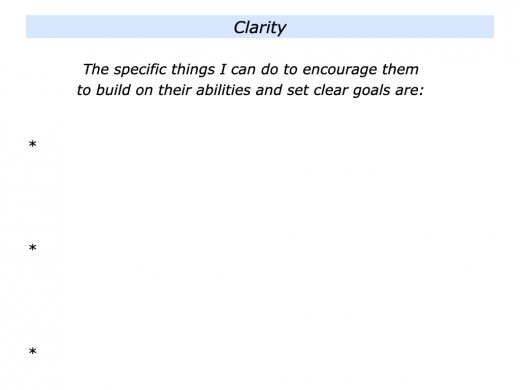
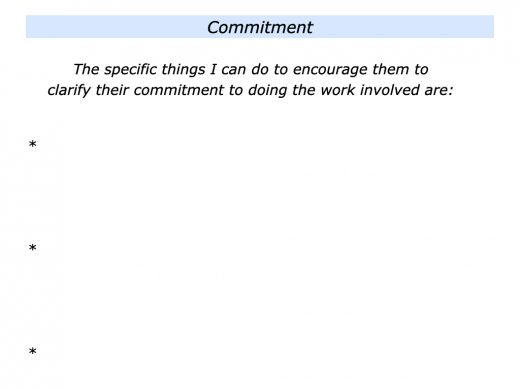
Step Three: Consistently
High Standards And Class
This involves helping the person to pursue the strategies and skills required to consistently deliver high standards. It also calls for encouraging them to go a step further and add that touch of class.
Different people take this step in different ways. Some people develop a sense of purpose. They then keep focusing on delivering high personal and professional standards.
This is an approach described by Clayton Christensen in the book he wrote with James Allworth and Karen Dillon called How Will You Measure Your Life?
Well-known for his work on entrepreneurship, Clayton also taught his students at Harvard to focus on their core principles. Here are some of the themes he described in an interview he gave the Harvard Business Review.
How Will You Measure Your Life?
I ask my students to find cogent answers to three questions.
How can I be sure that I’ll be happy in my career?
How can I be sure that my relationships with my spouse and my family become an enduring source of happiness?
How can I be sure that I’ll behave with integrity during my life?
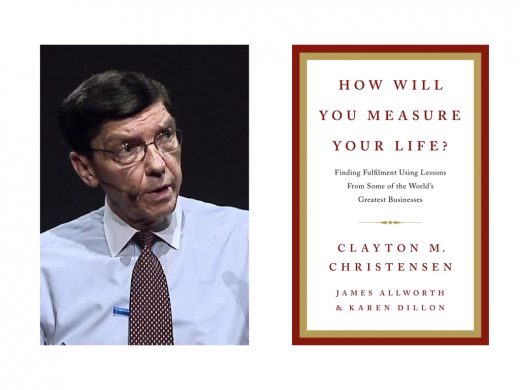
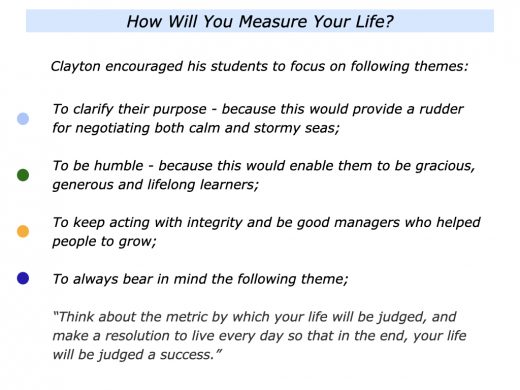
Clayton often demonstrated a touch of class. He did this by listening to people and treating with respect. When appropriate, he passed on knowledge that enabled them to achieve success.
Different people add class in different ways. Some do it by being kind. Some do it by using their strengths to produce something special that gives people a positive memory for life.
Let’s return to the person you may be trying to help. How can you enable them to deliver consistently high standards? How can you encourage them to add that touch of class?
There are many ways to help people to build on what they can do. If you wish, try tackling the final exercise on this theme. This invites you to complete the following sentences.
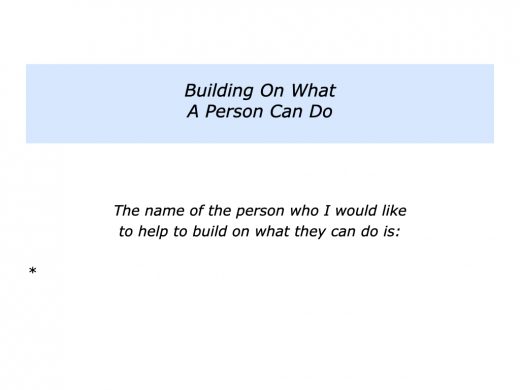
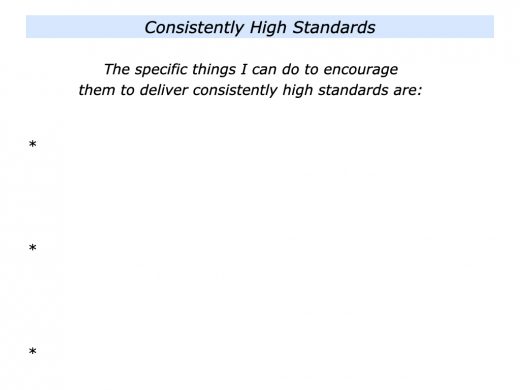
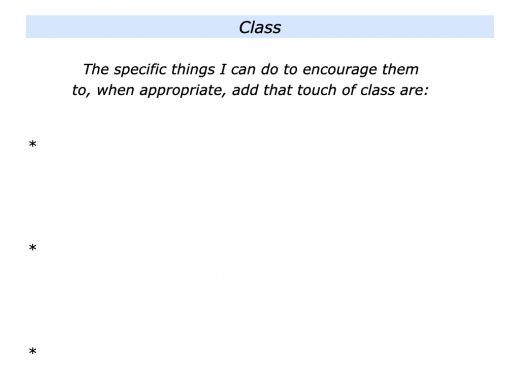


Leave a Reply